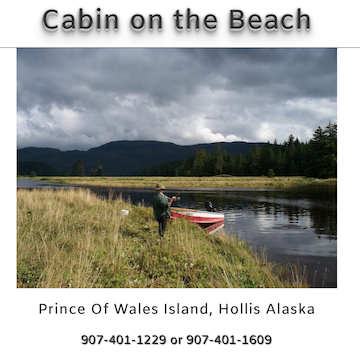Tlingit and Haida people of Alaska is a great Facebook page to follow! Please do so [here].
None of the Haida place names on Prince of Wales Island, except for Kasaan, are of Tlingit origin. Kasaan was actually Gus Kuu (the place where everything starts out from). Tlingit visitors were really impressed by the beauty of the location so referred to it as Ḵasa'aa (beautiful place). Haidas were flattered by the label and started using it. My source was my Uncle Louis Kitkoon. Here is how "Shipwreck" got its name.
SHIPWRECK
by Dr. Woodrow Ḵaawan Sangáa, BA. JD.
“Shipwreck” is a point of land, with some islands located about 10 miles west of the old Haida village, Hlan-gwáan – Lots-of-Land (or Klinkwan), and about 20 miles south of Hydaburg. It is named “Shipwreck” because a European Ship ran aground there and sunk.
Hunter's Bay lies immediately south of Hlan-gwáan (Klinkwan) – maybe 5 miles or less – with a major salmon-producing stream. There was a Saltry there then, later a salmon cannery. In the mid to late 1800's it was a frequent destination for European sailing ships.
Just such a ship was anchored near Hlan-gwáan (Klinkwan) and, the village was feeding them and engaged in trade. The Captain announced that his ship was to depart on the following day. Upon hearing the news, SG̱áagaa (the Haida Spirit Man) approached the ship's captain and said to him. “We should check the weather first.”
The ship's captain laughed, waved his hand to indicated the sky and said, “Look. There is not a cloud in the sky and, there is only a light westerly breeze. The weather is fine. We sail tomorrow.”
SG̱áagaa said to the ship's captain. “Come with me to the beach.” And began walking toward the ocean with the Captain following. SG̱áagaa was carrying a flat piece of wood 4 inches wide and about a foot long that resembled a piece of a shingle. There was a small hole in the center of the wood and a 6 inch dowel (the size of a wooden pencil) was inserted into the hole, making it look like a ship's mast. There was a small piece of cloth tied to the top of the “mast”.
SG̱áagaa said, “If this floats, you sail. If it sinks, you wait one more day.” Then he waded out a short distance from the shore and set the sailboat–like piece of wood in the water's surface. He turned and waded ashore and sat down on a rock. Both men watched...
It sat there bobbing on the surface of the water... then it began to sink. Finally it submerged below the surface until not even the top of the “mast” was showing. SG̱áagaa looked up at the Captain who laughed and said, “A good trick. We sail tomorrow.”
The following morning, the ship weighed anchor and set sail into a mild westerly wind. Once clear of the bay, more sails were hoisted and the captain steered a course to the Southwest, intending to clear Barrier Islands lying to the south in an east-west direction.
The ship was about 2 or 3 miles short of clearing the islands when the wind suddenly shifted to blowing from the Southwest. Clouds came rolling in and within an hour there was a gale blowing. It drove the ship to the northeast and, with no sea-room in which to maneuver, the ship was driven aground on a large rock. And, the ship began breaking up.
Captain and crew stayed with the ship because to try to get ashore would have been suicidal. Toward evening the wind died down and the waves were abating. The Captain sent some of his crew ashore with a very large rope and it was tied to the shore to keep the ship from possibly sliding off the rock into deeper water.
Early the next morning canoes from Hlan-gwáan (Klinkwan) arrived and the men and women began salvaging what they could get. That Captain, and his crew, sat on the beach and watch the salvagers. Finally there was nothing left to salvage. The canoes returned, with that Captain and his surviving crew members following in their boats.
One Haida and his nephew returned to Hlan-gwáan (Klinkwan) after the salvaging was completed. He had nothing but, he told his nephew, lets go and look at the wreck. When they arrived the tide was very low and they were able to wade around and look.
The man spotted something shiny in the water. So he and his nephew began picking up those shiny things. It was part of the ship's ballast, it was lead ingots. The Uncle and his nephew hauled lead ashore then took a load back to Hlan-gwáan (Klinkwan). He became a very wealthy man, selling lead (for Musket Balls and other uses). Oh, the weather turned out just as SG̱áagaa predicted.
That is how “Shipwreck” got its name.
This is the end of my story (gyaahláang).
Share, like and subscribe to this site
Send a tip or a story or a classified or hatemail to powreport@gmail.comSupport this site and make a small donation (and you'll receive the POW Court Report in an email)
Ads just 10$ a month





















No comments:
Post a Comment
Note: Only a member of this blog may post a comment.